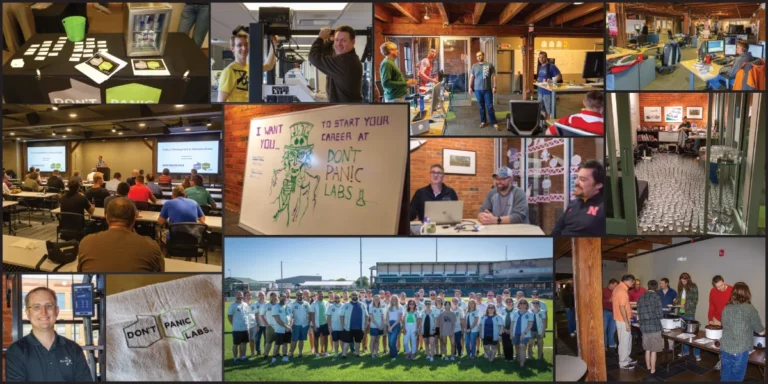
Our Big Employee Engagement Opportunity
The recent news cycle has been relentlessly documenting the effects of the pandemic on our workforce and attempting to predict where we all go from here. Almost every business leader I’ve spoken with recently has this as a concern. And it’s no wonder, given the sheer amount of change happening, the amount of uncertainty, and an onslaught of concerning trends.
A study released in March by Microsoft revealed that 41% of the global workforce (54% of Gen Z) is considering switching jobs within the next year. Employers left and right are grappling with structuring on-site, remote, or hybrid work amid evolving employee preferences. In broader IT, where we face a chronic shortage of skilled workers (Nebraska specifically having around 2,400 open IT positions at any given time according to code.org), these dynamics can feel overwhelming for any organization. Some are even calling this time the “Great Resignation,” and there is active debate about how extensive it will be. And as a final gut-punch, there’s even talk in our ecosystem of how east/west coast companies are now recruiting tech talent locally for permanent remote work at wages much higher than our prevailing rates.
Great employers are already reacting and engaging with their workforces to restructure themselves and retain talent. They’re creating opportunities for their employees to be heard. They’re raising wages, adding benefits, investing in DEI (diversity, equity, and inclusion) initiatives, and spending lots of cycles working to figure out how to embrace remote or hybrid work strategies.
But what if there’s an additional opportunity that we’re overlooking?
We’re still struggling as a society to broadly help our employees fully self-actualize and reach our full creative self. If we look at how this intersects with work, the most recent Gallup statistics on U.S. employee engagement show that only 34% of our employees are “engaged.” And this isn’t a blip—it’s been slowly increasing from 26% approximately 20 years ago. Likewise, 14% of our workforce is actively “disengaged,” a slight improvement from 18% over the same period. The overall effect on our economy is massive. To save you from the math, this means that half (51%) of our workforce is “not engaged.”
Time to Think Different
What if the pandemic could simply become the wake-up shock we all needed to break out of daily routines and, to borrow a phrase from Apple, “Think Different”? Employees are clearly rethinking what is important to them. Employers are making changes (i.e., remote and hybrid working) that allows for more labor mobility. How might we help all parties “Think Different” in a way that might break out of the engagement challenge we’re in? How might the conversation change if we add additional considerations?
In his book Drive, Daniel Pink proposed a simple framework for motivating/engaging employees involving autonomy, mastery, and purpose. As I look at the current conversations with this lens, it seems that so much of the focus revolves around autonomy and mastery but doesn’t leverage the power of purpose. I propose it is now time for organizations to lean strongly into their Mission/Purpose and Values to attract, retain, and ultimately increase the engagement of their employees.
During employment conversations, it’s easy to get fixated on one dimension that is the most important to an individual at any given time (i.e., salary, benefits, working conditions, etc.). The problem in my experience is that personal priorities change over time. Decisions based or weighted heavily on a single dimension led to shorter or more transactional relationships. To move the needle on engagement, we need to move beyond transactional relationships between employees and employers. The broader and deeper the relationship, the more fulfilling and rewarding it is to all involved. And this will ultimately lead to more engaged relationships.
Leaning Into Purpose
What might it look like to lean more strongly into purpose? The first step to making this happen is to re-affirm and communicate your mission/purpose and values within your organization. This defensive move will help employees considering a change realize there might be an added dimension to consider before making a switch.
Next, it’s time to go on the offense, get loud, and communicate this beyond your walls. Your organization now has an opportunity to reach more prospective employees as they’re potentially looking over larger geographical areas thanks to remote and hybrid work. Help them realize that a place exists for them to have a purpose as they work.
I believe a deeper focus on this intangible but critical aspect will help personnel look beyond any individual dimension and evaluate the employer-employee connection much more holistically. Additionally, employers who may not be able to dominate in any one dimension (such as highest pay, etc.) will be able to more strongly compete by leveraging their purpose and creating meaning in work. And now with remote and hybrid work becoming more common, there’s an opportunity for more employees and employers to connect over a passion for purpose.
We also know that engagement creates a big impact beyond an individual’s wellbeing. One report from HBR states that high levels of engagement translate into 22% higher productivity, 25-65% less turnover, 48% fewer safety incidents, 41% fewer quality incidents, and increased overall success. And finally, in industries with chronic open positions, we might be able to close some of that gap with the increased productivity from engaged workers. Might a more engaged workforce be a partial solution in industries experiencing chronic labor shortages?
At Don’t Panic Labs, our purpose is to bring every innovator’s vision to life. Every year we’re fortunate enough to speak with people who have a vision to improve some portion of our lives and try to help them see if it just might work. Albert Einstein once said, “If at first the idea is not absurd, then there is no hope for it.” Although we have strong opinions formed from our experience, we strive to genuinely meet everyone where they are and help them take steps forward. And when we find a mutual fit, we get to bring 20-30 products to life each year. As a small organization, we’re not in a position to help every innovator. But our purpose challenges us to keep striving to expand our impact and help more and more innovators get the chance to see if they can make a difference too.
What is your organization’s purpose? How might you share it more clearly, both internally and externally? Together let’s use this unique moment in history to finally help align people and organizations in a way that helps them self-actualize themselves and make a difference in the world.
Sources
Employers, Don’t Fear The ‘Great Resignation’—It’s Already Here (forbes.com)
U.S. Employee Engagement Reverts Back to Pre-COVID-19 Levels (gallup.com)
Employee Engagement Does More than Boost Productivity (hbr.org)



